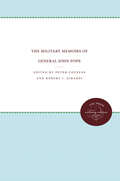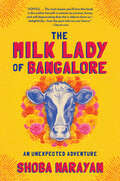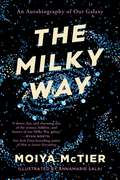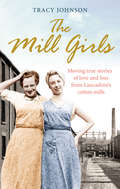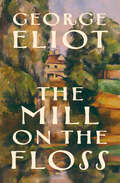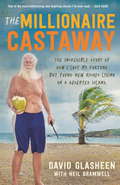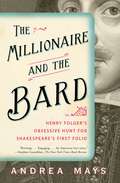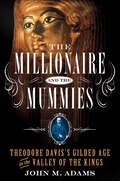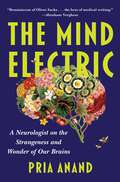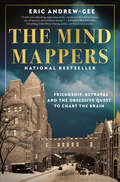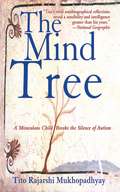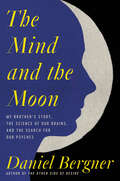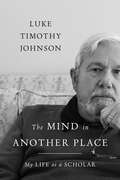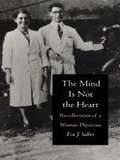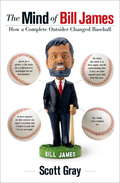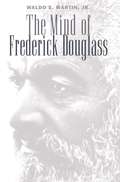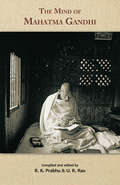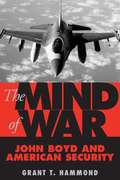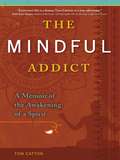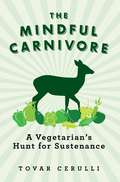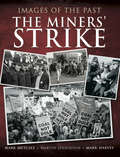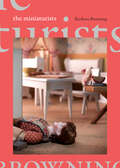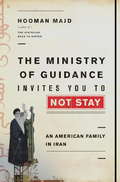- Table View
- List View
The Military Memoirs of General John Pope (Civil War America)
by Peter Cozzens Robert I. GirardiUnion general John Pope was among the most controversial andmisunderstood figures to hold major command during the Civil War.Before being called east in June 1862 to lead the Army of Virginia against General Robert E. Lee, he compiled an enviable record in Missouri and as commander of the Army of the Mississippi. After his ignominious defeat at the Second Battle of Bull Run, he was sent to the frontier. Over the next twenty-four years Pope held important department commands on the western plains and was recognized as one of the army's leading authorities on Indian affairs, but he never again commanded troops in battle. In 1886, Pope was engaged by the National Tribune, aweekly newspaper published in Washington, D.C., to write a seriesof articles on his wartime experiences. Over the next five years, in twenty-nine installments, he wrote about the war as he had lived it. Collected here for the first time, Pope's "war reminiscences" join a select roster of memoirs written by Civil War army commanders. Pope presents a detailed review of the campaigns in which heparticipated and offers vivid character sketches of such illustrious figures as Abraham Lincoln and Secretary of War Edwin M. Stanton. Clearly written and balanced in tone, his memoirs are a dramatic and important addition to the literature on the Civil War.Originally published in 1998.A UNC Press Enduring Edition -- UNC Press Enduring Editions use the latest in digital technology to make available again books from our distinguished backlist that were previously out of print. These editions are published unaltered from the original, and are presented in affordable paperback formats, bringing readers both historical and cultural value.
The Milk Lady of Bangalore: An Unexpected Adventure
by Shoba NarayanThe elevator door opens. A cow stands inside, angled diagonally to fit. It doesn’t look uncomfortable, merely impatient. “It is for the housewarming ceremony on the third floor,” explains the woman who stands behind the cow, holding it loosely with a rope. She has the sheepish look of a person caught in a strange situation who is trying to act as normal as possible. She introduces herself as Sarala and smiles reassuringly. The door closes. I shake my head and suppress a grin. It is good to be back. When Shoba Narayan—who has just returned to India with her husband and two daughters after years in the United States—asks whether said cow might bless her apartment next, it is the beginning of a beautiful friendship between our author and Sarala, who also sells fresh milk right across the street from that thoroughly modern apartment building. The two women connect over not only cows but also family, food, and life. When Shoba agrees to buy Sarala a new cow, they set off looking for just the right heifer, and what was at first a simple economic transaction becomes something much deeper, though never without a hint of slapstick.The Milk Lady of Bangalore immerses us in the culture, customs, myths, religion, sights, and sounds of a city in which the twenty-first century and the ancient past coexist like nowhere else in the world. It’s a true story of bridging divides, of understanding other ways of looking at the world, and of human connections and animal connections, and it’s an irresistible adventure of two strong women and the animals they love.
The Milky Way: An Autobiography of Our Galaxy
by Moiya McTierIn this approachable and fascinating biography of the galaxy, an astrophysicist and folklorist details everything humans have discovered—from the Milky Way's formation to its eventual death, and what else there is to learn about the universe we call home. After a few billion years of bearing witness to life on Earth, of watching one hundred billion humans go about their day-to-day lives, of feeling unbelievably lonely, and of hearing its own story told by others, The Milky Way would like a chance to speak for itself. All one hundred billion stars and fifty undecillion tons of gas of it. It all began some thirteen billion years ago, when clouds of gas scattered through the universe's primordial plasma just could not keep their metaphorical hands off each other. They succumbed to their gravitational attraction, and the galaxy we know as the Milky Way was born. Since then, the galaxy has watched as dark energy pushed away its first friends, as humans mythologized its name and purpose, and as galactic archaeologists have worked to determine its true age (rude). The Milky Way has absorbed supermassive (an actual technical term) black holes, made enemies of a few galactic neighbors, and mourned the deaths of countless stars. Our home galaxy has even fallen in love. After all this time, the Milky Way finally feels that it's amassed enough experience for the juicy tell-all we've all been waiting for. Its fascinating autobiography recounts the history and future of the universe in accessible but scientific detail, presenting a summary of human astronomical knowledge thus far that is unquestionably out of this world. NAMED A BEST BOOK OF 2022 BY PUBLISHERS WEEKLY AND SCIENCENET NAMED A BEST AUDIOBOOK OF 2022 BY BOOKPAGE
The Mill Girls: Moving true stories of love and loss from inside Lancashire's cotton mills
by Tracy Johnson'I dragged my heels all the way to the mill. ‘I can’t do it!’ I sulked. Mother sighed and shook her head. My heart sank. Of course, I’d seen the mill hundreds of times before, but now it was different – now, I was going in. I’d never seen a place so depressing; I wanted to cry.'With tales from hardworking Audrey and mischievous Maureen to high-spirited Doris and dedicated Marjorie, The Mill Girls is an evocative story of hardship and friendship from when cotton was still king. Through the eyes of these northern mill girls, we are offered a fascinating glimpse into the lives of ordinary women who rallied together, nattered over the beamers and, despite the difficult conditions, weaved, packed and laughed to keep the cotton mills spinning.
The Mill on the Floss: Large Print
by George EliotThe classic tale of one young woman&’s quest for fulfillment in 1820s England, and the price she would pay for true freedom. Maggie Tulliver&’s entire life has been spent in the shadow of Dorlcote Mill on the River Floss with her beloved older brother, Tom. But when their father meets an untimely death, the siblings&’ singular bond is strained as Tom is forced to leave his studies and Maggie struggles to find a sense of belonging. Maggie&’s sharp intelligence and spirited nature have made her an oddity in the rural hamlet of St. Ogg&’s, where such unique qualities are perceived as unbecoming for a woman. Her need for recognition and love eventually drives her to defy her brother, who casts her out of his house to survive on her own. Forced to grieve the losses of both their father and each other, the siblings will have to find it in their hearts to forgive in order to reconcile before tragedy strikes again. Inspired by events in the life of the author, The Mill on the Floss is George Eliot&’s most heartfelt novel and one of her most compelling and moving works. This ebook has been professionally proofread to ensure accuracy and readability on all devices.
The Millionaire Castaway
by Dave Glasheen Neil BramwellDave Glasheen’s life began spiralling out of control after he lost his family’s vast fortune in the stock market crash of 1987. After a series of catastrophes, he needed to take drastic measures to restore himself. Opting out of the rat race, he cast himself away to a deserted island off the north-east tip of Australia, as far off the grid as was humanly possible. He has lived there ever since.One annual supermarket shop, a sketchy internet connection, and enough ingredients for a home brew satisfy Dave’s material needs. He catches fish, traps rainwater and cooks on an open fire. For company he tames dingoes, meets with friends from the Aboriginal community 40 kilometres away, and entertains drop-ins such as Russell Crowe sailing past on his honeymoon. Then there’s Dave’s running feud with Boxhead, an antisocial saltwater crocodile who just won’t leave him in peace.Between heartbreak and hair-raising adventures, Dave has found happiness on Restoration Island. Brimming with humour, eccentricity and hard-earned wisdom, The Millionaire Castaway will give you a whole new view on life.
The Millionaire and the Bard
by Andrea MaysToday it is the most valuable book in the world. Recently one sold for over five million dollars. It is the book that rescued the name of William Shakespeare and half of his plays from oblivion. The Millionaire and the Bard tells the miraculous and romantic story of the making of the First Folio, and of the American industrialist whose thrilling pursuit of the book became a lifelong obsession.When Shakespeare died in 1616 half of his plays died with him. No one--not even their author--believed that his writings would last, that he was a genius, or that future generations would celebrate him as the greatest author in the history of the English language. By the time of his death his plays were rarely performed, eighteen of them had never been published, and the rest existed only in bastardized forms that did not stay true to his original language. Seven years later, in 1623, Shakespeare's business partners, companions, and fellow actors, John Heminges and Henry Condell, gathered copies of the plays and manuscripts, edited and published thirty-six of them. This massive book, the First Folio, was intended as a memorial to their deceased friend. They could not have known that it would become one of the most important books ever published in the English language, nor that it would become a fetish object for collectors. The Millionaire and the Bard is a literary detective story, the tale of two mysterious men--a brilliant author and his obsessive collector--separated by space and time. It is a tale of two cities--Elizabethan and Jacobean London and Gilded Age New York. It is a chronicle of two worlds--of art and commerce--that unfolded an ocean and three centuries apart. And it is the thrilling tale of the luminous book that saved the name of William Shakespeare "to the last syllable of recorded time."
The Millionaire and the Mummies: Theodore Davis's Gilded Age in the Valley of the Kings
by John M. AdamsA biography of the Gilded Age American lawyer & tycoon, exploring his exploits from New York City’s government to the ancient tombs in Luxor, Egypt.Egypt, the Valley of the Kings, 1905: An American robber baron peers through the hole he has cut in an ancient tomb wall and discovers the richest trove of golden treasure ever seen in Egypt.At the start of the twentieth century, Theodore Davis was the most famous archaeologist in the world. His career turned tomb-robbing and treasure-hunting into a science. Using six of Davis’s most important discoveries—from the female Pharaoh Hatshepsut’s sarcophagus to the exquisite shabti statuettes looted from the Egyptian Museum not too long ago—as a lens around which to focus his American rags-to-riches tale, author John M. Adams chronicles the rise of a poor country preacher’s son. Through corruption and fraud, Davis amassed tremendous wealth in Gilded Age New York and then atoned for his ruthless career by inventing new standards for systematic excavation in the field of archaeology. He found a record eighteen tombs in the Valley and, breaking with custom, gave all the spoils of his discoveries to museums. A confederate of Boss Tweed, friend of Teddy Roosevelt, and rival of J. P. Morgan, the colorful “American Lord Carnarvon” shared his Newport mansion with his Rembrandts, his wife, and his mistress. The only reason history has forgotten Davis to a large extent is probably the fact that he stopped just short of King Tutankhamen’s tomb, the discovery of which propelled Howard Carter (Davis’s erstwhile employee) to worldwide fame just a few short years later.Drawing on rare and never-before-published archival material, The Millionaire and the Mummies, the first biography of Theodore Davis ever written, rehabilitates a tarnished image through a thrilling tale of crime and adventure, filled with larger-than-life characters, unimaginable treasures, and exotic settings.
The Mind Electric: A Neurologist on the Strangeness and Wonder of Our Brains
by Pria AnandIn this collection of medical tales &“reminiscent of Oliver Sacks...the best of medical writing&” (Abraham Verghese, author of The Covenant of Water), a neurologist reckons with the stories we tell about our brains, and the stories our brains tell us.A girl believes she has been struck blind for stealing a kiss. A mother watches helplessly as each of her children is replaced by a changeling. A woman is haunted each month by the same four chords of a single song. In neurology, illness is inextricably linked with narrative, the clues to unraveling these mysteries hidden in both the details of a patient's story and the tells of their body. Stories are etched into the very structure of our brains, coded so deeply that the impulse for storytelling survives and even surges after the most devastating injuries. But our brains are also porous—the stories they concoct shaped by cultural narratives about bodies and illness that permeate the minds of doctors and patients alike. In the history of medicine, some stories are heard, while others—the narratives of women, of Black and brown people, of displaced people, of disempowered people—are too often dismissed. In The Mind Electric, neurologist Pria Anand reveals—through case study, history, fable, and memoir—all that the medical establishment has overlooked: the complexity and wonder of brains in health and in extremis, and the vast gray area between sanity and insanity, doctor and patient, and illness and wellness, each separated from the next by the thin veneer of a different story. Moving from the Boston hospital where she treats her patients, to her childhood years in India, to Isla Providencia in the Caribbean and to the Republic of Guinea in West Africa, she demonstrates again and again the compelling paradox at the heart of neurology: that even the most peculiar symptoms can show us something universal about ourselves as humans.
The Mind Mappers: Friendship, Betrayal and the Obsessive Quest to Chart the Brain
by Eric Andrew-GeeThe riveting true story of the star-crossed friendship between two neuroscientists—one famous, the other forgotten—who mapped the brain, but lost each other.In the early 1920s, when neurosurgery was more likely to be a death sentence than a cure, two men revolutionized the study of the brain: Wilder Penfield and William Cone. Drawn together by their shared fascination with the &“undiscovered country&” inside our heads, the surgeons formed a partnership and within ten years established the Montreal Neurological Institute in a Gothic stone hospital on the slope of a mountain. The Neuro soon became the world&’s leading centre for neurological study, attracting men and women from across the globe to a booming mid-century city.But their success came at the cost of their friendship.While Cone spent long hours at patients&’ bedsides and in the blood-spattered operating room, Penfield pursued the loftier goal of discovering the seat of consciousness. The Chief, as he was known, went on to develop the Montreal procedure for treating epilepsy, which helped identify the source of speech, executive function and memory in narrow slivers of grey matter—achievements that illuminated the relationship between mind and body, made possible by Cone&’s anonymous work behind the scenes. Over time, their relationship became fraught with personal and professional hurts—and suddenly ended when Cone was found dead in his office at the age of sixty-two.In this compelling dual biography, Globe and Mail journalist Eric Andrew-Gee weaves together the rich history of The Neuro with that of Penfield and Cone to reveal the untold story of one of the birthplaces of neuroscience. In doing so, he breathes new life into a familiar hero and revives the tragic, forgotten story of his partner, writing Dr. William Cone back into the historical record at last.
The Mind Tree: A Miraculous Child Breaks the Silence of Autism
by Tito Rajarshi MukhopadhyayWell-received on initial publication, The Mind Tree is truly an enthralling read. Although he is severely autistic and nearly nonverbal, Tito's ability to communicate through his extraordinary writing is astonishing. At the age of three, Tito was diagnosed with severe autism. But his mother, with boundless hope and determination, read to him and taught him to write in English. She also challenged him to write his own stories. The result of their efforts is this remarkable book-written when he was eight to eleven years old-comprised of profound and startling philosophical prose and poetry. During a New York Times interview, Tito scrawled on a yellow pad, "I need to write . . . It has become a part of me."
The Mind and the Moon: My Brother's Story, the Science of Our Brains, and the Search for Our Psyches
by Daniel Bergner“A profound and powerful work of essential reporting." —The New York Times Book ReviewAn important—and intimate—interrogation of how we treat mental illness and how we understand ourselvesIn the early 1960s, JFK declared that science would take us to the moon. He also declared that science would make the “remote reaches of the mind accessible” and cure psychiatric illness with breakthrough medications. We were walking on the moon within the decade. But today, psychiatric cures continue to elude us—as does the mind itself. Why is it that we still don’t understand how the mind works? What is the difference between the mind and the brain? And given all that we still don’t know, how can we make insightful, transformative choices about our psychiatric conditions?When Daniel Bergner’s younger brother was diagnosed as bipolar and put on a locked ward in the 1980s, psychiatry seemed to have achieved what JFK promised: a revolution of chemical solutions to treat mental illness. Yet as Bergner’s brother was deemed a dire risk for suicide and he and his family were told his disorder would be lifelong, he found himself taking heavy doses of medications with devastating side effects.Now, in recounting his brother’s journey alongside the gripping, illuminating stories of Caroline, who is beset by the hallucinations of psychosis, and David, who is overtaken by depression, Bergner examines the evolution of how we treat our psyches. He reveals how the pharmaceutical industry has perpetuated our biological view of the mind and our drug-based assumptions about treatment—despite the shocking price paid by many patients and the problematic evidence of drug efficacy. And he takes us into the pioneering labs of today’s preeminent neuroscientists, sharing their remarkably candid reflections and fascinating new theories of treatment.The Mind and the Moon raises profound questions about how we understand ourselves and the essential human divide between our brains and our minds. This is a book of thought-provoking reframings, delving into the science—and spirit—of our psyches. It is about vulnerability and personal dignity, the terrifying choices confronted by families and patients, and the prospect of alternatives. In The Mind and the Moon, Bergner beautifully explores how to seek a deeper engagement with ourselves and one another—and how to find a better path toward caring for our minds.
The Mind in Another Place: My Life as a Scholar
by Luke Timothy JohnsonA witness to the peculiar way of being that is the scholar&’s Luke Timothy Johnson is one of the best-known and most influential New Testament scholars of recent decades. In this memoir, he draws on his rich experience to invite readers into the scholar&’s life—its aims, commitments, and habits. In addition to sharing his own story, from childhood to retirement, Johnson reflects on the nature of scholarship more generally, showing how this vocation has changed over the past half-century and where it might be going in the future. He is as candid and unsparing about negative trends in academia as he is hopeful about the possibilities of steadfast, disciplined scholarship. In two closing chapters, he discusses the essential intellectual and moral virtues of scholarly excellence, including curiosity, imagination, courage, discipline, persistence, detachment, and contentment. Johnson&’s robust defense of the scholarly life—portrayed throughout this book as a generative process of discovery and disclosure—will inspire both new and seasoned scholars, as well as anyone who reads and values good scholarship. But The Mind in Another Place ultimately resonates beyond the walls of the academy and speaks to matters more universally human: the love of knowledge and the lifelong pursuit of truth.
The Mind is Not the Heart: Recollections of a Woman Physician
by Eva J. SalberAvailable for the first time in paperback, Eva Salber's The Mind Is Not the Heart (originally published in 1989), is the personal and political story of a white, Jewish, South African woman who practiced medicine for over fifty years among the impoverished--both rural and urban, black and white, in South Africa and later in the United States. Her lifelong dedication to providing health care to poor people was informed by a passionate vision of the link between social problems and medicine, accompanied by an embracing involvement with the communities in which she served. In this warm clear-eyed account, Dr. Salber presents not only her own personal journey, that of a professional woman, teacher, wife, and mother, but also the story of the people on the margins of society among whom she worked.
The Mind of Bill James
by Scott GrayThe first book to chronicle the life and ideas of “the serious baseball fan’s high priest” (New York Times), the impact of his brilliant and entertaining writings, and how someone who never pitched a ball, held a bat, or managed a team fundamentally changed the way baseball is interpreted, analyzed, and even played. Bill James has been called “baseball’s shrewdest analyst” (Slate) and “part of baseball legend” (The New Yorker), and hisBaseball Abstracthas been acclaimed as the “holy book of baseball” (Chicago Tribune). Thirty years ago, James introduced a new approach to evaluating players and strategies, and now his theories have become indispensable tools for agents, statistics analysts, maverick general managers, and anyone who is serious about understanding the game. James began writing about baseball while working at a factory in his native Kansas. In lively, often acerbic prose, he used statistics to challenge entrenched beliefs and uncover surprising truths about the game. His annualBaseball Abstractcaptured the attention of fans and front offices and went on to become a bestselling staple of the baseball book category. In 2002, the Boston Red Sox hired James as an advisor. Two years later they achieved their long-awaited World Series triumph. The Mind of Bill Jamestells the story of how a gifted outsider inspired a new understanding of baseball. It delves deeply into James’s essential wisdom–including his surprising beliefs about pitch counts and the importance of batting-order, thoughts on professionalism and psychology, and why teams tend to develop the characteristics that are least favored by their home parks. It also brings together his best writing, much of it long out of print, as well as insights from new interviews. Written with James’ full cooperation, it is at once an eye-opening portrait of baseball’s virtuoso analyst and a treasury of his idiosyncratic genius.
The Mind of Frederick Douglass
by Waldo E. MartinFrederick Douglass was unquestionably the foremost black American of the nineteenth century. The extraordinary life of this former slave turned abolitionist orator, newspaper editor, social reformer, race leader, and Republican party advocate has inspired many biographies over the years. This, however, is the first full-scale study of the origins, contours, development, and significance of Douglass's thought.Brilliant and to a large degree self-taught, Douglass personified intellectual activism; he possessed a sincere concern for the uses and consequences of ideas. Both his people's struggle for liberation and his individual experiences, which he envisioned as symbolizing that struggle, provided the basis and structure for his intellectual maturation. As a representative American, he internalized and, thus, reflected major currents in the contemporary American mind. As a representative Afro-American, he revealed in his thinking the deep-seated influence of race on Euro-American, Afro-American, or, broadly conceived, American consciousness. He sought to resolve in his thinking the dynamic tension between his identities as a black and as an American.Martin assesses not only how Douglass dealt with this enduring conflict, but also the extent of his success. An inveterate belief in a universal and egalitarian humanism unified Douglass's thought. This grand organizing principle reflected his intellectual roots in the three major traditions of mid-nineteenth-century American thought: Protestant Christianity, the Enlightenment, and romanticism. Together, these influences buttressed his characteristic optimism. Although nineteenth-century Afro-American intellectual history derived its central premises and outlook from concurrent American intellectual history, it offered a searching critique of the latter and its ramifications. How to square America's rhetoric of freedom, equality, and justice with the reality of slavery and racial prejudice was the difficulty that confronted such Afro-American thinkers as Douglass.
The Mind of Mahatma Gandhi
by M. K. GandhiOnly now and again does there arise above the common level some rare spirit, who, having thought about God more deeply, reflects more clearly the divine purpose and puts into practice more courageously the divine guidance. The light of such shines like a strong beacon on a dark and disordered world. Gandhi belongs to the race of the prophets who have the courage of the heart, the courtesy of the spirit and the laughter of the unafraid. Through his life and teaching, he bears testimony to the values for which this country has stood for ages, faith in spirit, respect for its mysteries, the beauty of holiness, the acceptance of life’s obligations, the validity of character, values which are neither national nor international, but universal. … There is so much misunderstanding today about Gandhi’s views and ways of thinking. This book, where we find collected together the relevant extracts from Gandhi’s own writings on the central principles of his faith and conduct, will help to make Gandhi’s position clearer to the modern mind. [From Foreword, 1945] S. Radhakrishnan
The Mind of St. Paul
by William BarclayFrom the Preface: These chapters originally appeared as a series of weekly articles in the pages of The British Weekly. ... To the original series I have added two chapters, one on Sin and the other on the Church in the thinking of Paul. These chapters do not in any way claim to be an exhaustive and complete Theology of Paul. I have simply gone direct to the Pauline letters to find out what Paul said and thought on certain great subjects. Their aim will be fulfilled, if they send people back to the reading of Paul's letters themselves. This is a well-documented presentation of Paul's ideas. It is easy to read and quite interesting.
The Mind of War: John Boyd and American Security
by Grant HammondThe ideas of US Air Force Colonel John Boyd have transformed American military policy and practice. A first-rate fighter pilot and a self-taught scholar, he wrote the first manual on jet aerial combat; spearheaded the design of both of the Air Force's premier fighters, the F-15 and the F-16; and shaped the tactics that saved lives during the Vietnam War and the strategies that won the Gulf War. Many of America's best-known military and political leaders consulted Boyd on matters of technology, strategy, and theory.In The Mind of War, Grant T. Hammond offers the first complete portrait of John Boyd, his groundbreaking ideas, and his enduring legacy. Based on extensive interviews with Boyd and those who knew him as well as on a close analysis of Boyd's briefings, this intellectual biography brings the work of an extraordinary thinker to a broader public.From the Trade Paperback edition.
The Mindful Addict
by Tom CattonThe enlightening and worldly journeys of a once hopeless addict whose life was profoundly changed after a chance meeting with a nomadic spiritual healer.
The Mindful Carnivore: A Vegetarian's Hunt for Sustenance
by Tovar CerulliA vegan-turned-hunter reignites the connection between humans and our food sources and continues the dialog begun by Michael Pollan and Barbara Kingsolver. While still in high school, Tovar Cerulli experimented with vegetarianism and by the age of twenty, he was a vegan. Ten years later, in the face of declining health, he would find himself picking up a rifle and heading into the woods. Through his personal quest, Tovar Cerulli bridges disparate worldviews and questions moral certainties, challenging both the behavior of many hunters and the illusion of blamelessness maintained by many vegetarians. In this time of intensifying concern over ecological degradation, how do we make peace with the fact that, even in growing organic vegetables, life is sustained by death? Drawing on personal anecdotes, philosophy, history and religion, Cerulli shows how America's overly sanitized habits of consumption and disconnection with our food have resulted in so many of the health and environmental crises we now face.
The Minds of Billy Milligan
by Daniel KeyesReconstructs the case of a young man who was arrested in 1977 as the Ohio "campus rapist." Under psychiatric observation he was found to possess twenty-four distinct personalities, including those of a lesbian, a painter, an Englishman, an escape artist, a con man, and a small deaf boy.
The Miners' Strike: Miners' Strike (Images of the Past)
by Mark Harvey Mark Metcalf Martin JenkinsonIn addition to being the most bitter industrial dispute the coalminers' strike of 1984/5 was the longest national strike in British history. For a year over 100,000 members of the National Union of Mineworkers, their families and supporters, in hundreds of communities, battled to prevent the decimation of the coal industry on which their livelihoods and communities depended. Margaret Thatcher's government aimed to smash the most militant section of the British working class. She wanted to usher in a new era of greater management control at work and pave the way for a radical refashioning of society in favour of neo-liberal objectives that three decades later have crippled the world economy.Victory required draconian restrictions on picketing and the development of a militarised national police force that made widespread arrests as part of its criminalisation policy. The attacks on the miners also involved the use of the courts and anti-trade union laws, restrictions on welfare benefits, the secret financing by industrialists of working miners and the involvement of the security services. All of which was supported by a compliant mass media but resisted by the collective courage of miners and mining communities in which the role of Women against Pit Closures in combating poverty and starvation was heroic. Thus inspired by the struggle for jobs and communities an unparalleled movement of support groups right across Britain and in other parts of the world was born and helped bring about a situation where the miners long struggle came close on occasions to winning.At the heart of the conflict was the Yorkshire region, where even at the end in March 1985, 83 per cent of 56,000 miners were still out on strike. The official Yorkshire National Union of Mineworkers (NUM) area photographer in 1984-85 was the late Martin Jenkinson and this book of his photographs some never previously seen before - serves as a unique social document on the dispute that changed the face of Britain.As featured in The Yorkshire Times, Sheffield Telegraph and NUJ News Leeds.
The Miniaturists
by Barbara BrowningIn The Miniaturists Barbara Browning explores her attraction to tininess and the stories of those who share it. Interweaving autobiography with research on unexpected topics and letting her voracious curiosity guide her, Browning offers a series of charming short essays that plumb what it means to ponder the minuscule. She is as entranced by early twentieth-century entomologist William Morton Wheeler, who imagined corresponding with termites, as she is by Frances Glessner Lee, the “mother of forensic science,” who built intricate dollhouses to solve crimes. Whether examining Honey, I Shrunk the Kids, the Schoenhut toy piano dynasty, portrait miniatures, diminutive handwriting, or Jonathan Swift’s and Lewis Carroll’s preoccupation with tiny people, Browning shows how a preoccupation with all things tiny can belie an attempt to grasp vast---even cosmic---realities.
The Ministry of Guidance Invites You to Not Stay
by Hooman MajdWith U.S.-Iran relations at a thirty-year low, Iranian-American writer Hooman Majd dared to take his young family on a year-long sojourn in Tehran. The Ministry of Guidance Invites You to Not Stay traces their domestic adventures and closely tracks the political drama of a terrible year for Iran's government. It was an annus horribilis for Iran's Supreme Leader. The Green Movement had been crushed, but the regime was on edge, anxious lest democratic protests resurge. International sanctions were dragging down the economy while talk of war with the West grew. Hooman Majd was there for all of it. A new father at age fifty, he decided to take his blonde, blue-eyed Midwestern yoga instructor wife Karri and his adorable, only-eats-organic infant son Khash from their hip Brooklyn neighborhood to spend a year in the land of his birth. It was to be a year of discovery for Majd, too, who had only lived in Iran as a child. The book opens ominously as Majd is stopped at the airport by intelligence officers who show him a four-inch thick security file about his books and journalism and warn him not to write about Iran during his stay. Majd brushes it off--but doesn't tell Karri--and the family soon settles in to the rituals of middle class life in Tehran: finding an apartment (which requires many thousands of dollars, all of which, bafflingly, is returned to you when you leave), a secure internet connection (one that persuades the local censors you are in New York) and a bootlegger (self-explanatory). Karri masters the head scarf, but not before being stopped for mal-veiling, twice. They endure fasting at Ramadan and keep up with Khash in a country weirdly obsessed with children. All the while, Majd fields calls from security officers and he and Karri eye the headlines--the arrest of an American "spy," the British embassy riots, the Arab Spring--and wonder if they are pushing their luck. The Ministry of Guidance Invites You to Not Stay is a sparkling account of life under a quixotic authoritarian regime that offers rare and intimate insight into a country and its people, as well as a personal story of exile and a search for the meaning of home.
